The sander is a tool that every self-respecting handyman should have in his toolbox. And the French seem to be aware of this: about 70,000 of these tools are sold each year. There are several types, but the most common are orbital sanders with or without eccentric, vibrating, belt and multi-functional. So which sander should you choose?
Here is our commitment, to make sure that we provide the best user experience and content quality:
You can support us by using our links to make your purchases (at no extra cost to you)! This sometimes earns us a commission which allows us to remain independent. More about us
Our selection
"The MAKITA DBO180Z is aggressive and efficient. It is a powerful sander, equipped with a large battery, but it is still well balanced."
"Compact, ergonomic and easy to use, the Bosch Q429091 offers maximum power without leaving any dust behind while working."
"The Bosch PBS 75 A is a well thought out tool designed to be used any way you want: upright, against walls, or on the…"
"The Bosch GSS 160-1 A is a powerful sander. When it comes to finishing furniture, this sander is useful, as it has an aluminum sanding…"
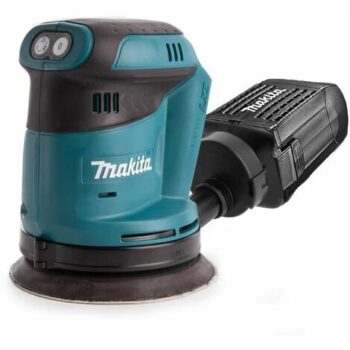
The MAKITA DBO180Z is aggressive and efficient. It is a powerful sander, equipped with a large battery, but it is still well balanced.
72,80 £ on ManoManoThe MAKITA DBO180Z packs as much punch as most mains-powered random orbital models, without the hassle that a cord brings. It's designed to work fast and, most importantly, leave a clean, swirl-free finish on any surface.
The only drawbacks are that the sander has a powerful gyroscopic action that requires a slight forward bias to keep the sanding on track. And it's a little too heavy for extended one-handed use.
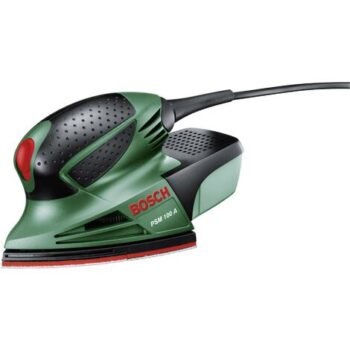
Compact, ergonomic and easy to use, the Bosch Q429091 offers maximum power without leaving any dust behind while working.
57,35 £ on Manomano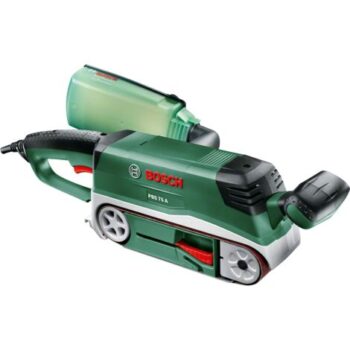
The Bosch PBS 75 A is a well thought out tool designed to be used any way you want: upright, against walls, or on the floor. This device will perfectly suit your needs.
104 £ on ManoManoThe Bosch PBS 75 A has automatic tightening and alignment of the ship-shaped belt, which provides good stability. Its 710W motor has enough power for the most demanding jobs, and the low-vibration system does a great job of minimizing the finger tingling you might get from extended sanding. The dust collector is not perfect unless you are sanding very small areas, so eye and mouth protection should not be overlooked.
You can get belt sanders for much less than the price of this one, but Bosch tools are known for their professional quality that is well worth the prices offered.

The Bosch GSS 160-1 A is a powerful sander. When it comes to finishing furniture, this sander is useful, as it has an aluminum sanding plate that helps with even sanding and gives you a perfect finish.
82,40 £ on ManomanoThe Bosch GSS 160-1 A is a comfortable and easy-to-use tool thanks in large part to its well-designed clamping system: the device is stable and sturdy, quite easy to handle.
The device weighs about 1 kg so you shouldn't have too much trouble holding it in an upright position or in front of you for short periods. The manufacturer could probably have done a better job of dusting, but the dust volume reduction is still decent.
Any specific needs?
Your guide :
Rate this buying guide :By rating this buying guide, you are helping us to reward our best writers. Thank you!
| TOP OF THE LINE | CHEAP | TOP OF THE LINE | VERY GOOD | |

In accordance with our commitment, this buying guide does not contain any sponsored products. |
 8/10 |
 7/10 |
 8/10 |
 7/10 |
| OUR SELECTION |
MAKITA DBO180Z
|
Bosch Q429091
|
Bosch PBS 75 A
|
Bosch GSS 160-1 A
|
|
The MAKITA DBO180Z is aggressive and efficient. It is a powerful sander, equipped with a large battery, but it is still well balanced.
|
Compact, ergonomic and easy to use, the Bosch Q429091 offers maximum power without leaving any dust behind while working.
|
The Bosch PBS 75 A is a well thought out tool designed to be used any way you want: upright, against walls, or on the floor. This device will perfectly suit your needs.
|
The Bosch GSS 160-1 A is a powerful sander. When it comes to finishing furniture, this sander is useful, as it has an aluminum sanding plate that helps with even sanding and gives you a perfect finish.
|
|
|
|
Powerful
|
Compact, ergonomic shape
|
Manual belt alignment is not required
|
Powerful motor
|
|
|
Long load time
|
Powerful 100W motor
|
Attractive, compact and durable design
|
Vibration-free and quiet
|
|
|
Incredible dust collection system
|
Zero dust trail
|
Easy to use
|
Efficient dust collection system
|
|
|
Low vibration
|
Optional dust extractor
|
Can be used for stationary work
|
Rugged clamping system
|
|
|
May have difficulty with hardwood
|
Self-gripping adhesive
|
Low cooling fan
|
One speed setting
|
Help us improve this table:
Report an error, request the addition of a feature to the table, or suggest another product. Thank you for your kindness!
We spend thousands of hours each year studying the major specialized websites, analyzing products of hundreds of brands and reading user feedback to advise you on the best products.
We are a product review company with a single mission: to simplify your buying decisions. Our research and testing helps millions of people every year find the best products for their personal needs and budget.
To support us you can: use our links to make your purchases (which often earns us a small commission), share our articles on social networks, or recommend our site on your blog. Thanks in advance for your support!
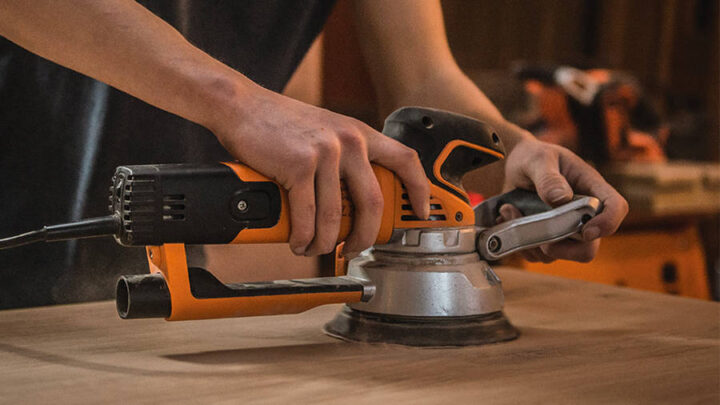
The power will vary between different sander models. You need to understand the specific horsepower of the tool you want to buy. It is determined by the motor and this will determine the type of tasks you can undertake with your sander.
Invest in a model that is built to last. That's why you need to pay close attention to the quality of the materials used to make the sander. For those who will be using the tool frequently, you cannot afford to compromise on the issue of durability.
Vibration can affect the result you get at the end of the sanding process. When you have a tool with high vibration levels, it can cause fatigue and a lot of discomfort during the work. You need to choose a model with very low vibration levels to ensure your safety and comfort.
All sanding tasks will inevitably generate a lot of dust, which can be dangerous and also creates a lot of damage. You should check the dust management system to see how effective it is. This will ensure that your work area is clean and that you have a good view of the work being done.
Be careful not to end up with a sander that is too complicated and difficult to use. Analyze the features of each tool to choose one that has an easy and quickly understandable grip.
When it comes to working with surfaces of various materials, grinders and sanders are among the most commonly used power tools. But beware, they do not have the same functions.
First of all, the angle grinder uses a specific disc and not an abrasive paper like sanders. Secondly, the grinder is better suited for more intensive work such as cutting metal bars, pipes, etc. It can also be used to remove old paint from metal surfaces, while sanders are best suited for wood and plastic surfaces.
In a store
You can buy your sander at hardware stores, especially those that cater to construction and furniture makers. However, you will probably have fewer choices, especially if you don't have the time to visit many of them.
Online
However, if you are looking for a wider range of prices, models and brands, the best option for you is to buy online. Products from all the major and minor brands are available (Bosh, Makita, DeWalt, Black+Decker, etc). If you decide to buy online, our favorite site for sanders is ManoMano. This site offers a good price/quality/customer service ratio.
Different types of sanders have different uses. Choosing the wrong tool will only create frustration and you won't get the results you want. There are four main types of sanders: random orbit sanders (eccentric orbital), detail sanders, vibratory sanders and belt sanders.
These sanders are compact, powerful and versatile. They are able to move in tight circles, so you don't have to follow the grain of the wood to get a swirl-free finish. They are often used to remove paint and varnish, clean metal and sand before and after applying sealers and wood finishes. Also known as an eccentric sander, it is also suitable for polishing rounded surfaces. This type of sander has versions equipped with telescopic arms: giraffes.
Benefits:
Disadvantages:
Who is it for?
Random orbital sanders are suitable for professionals and non-professionals who want to prepare a surface before and after painting, or who want an ultra-smooth finish on their work (on wood, plastic or metal).
Also
called precision sanders or detail sanders, they are ideal for small areas. They usually have a triangular-shaped pad to get into corners and tight spots. They require a custom-cut, self-sealing sandpaper available in a variety of grits. Some models come with finger pads for sanding around slots and grooves. They are ideal for sanding spindles and chair moldings.
Advantages:
Lightweight and portable
Two-piece sanding plate
Microfill system for efficient sanding
A dust extraction connection
Disadvantages:
Who is it for?
Multifunction sanders will be perfect for people who need to do very specific jobs: reaching difficult areas like corners and edges that need a good finish.
They
are an economical choice that can handle a variety of tasks. They feature square pads that can reach corners. The pads oscillate in two planes - front to back and side to side - to avoid swirl marks. This sander is ideal for removing paint and varnish, as well as preparing or finishing fairly large surfaces.
Advantages:
Disadvantages:
Who is it for?
They are suitable for beginner DIYers, as well as for smaller budgets: the sandpaper used here is fairly easy to find and inexpensive, as is the unit itself.
These sanders are heavier and more powerful than the others. It can remove more material and less time than the orbital sander, but it requires a higher skill level. As the name implies, the belt sander uses a pulley-driven belt operating at speeds of up to 20 km / h. This tool is ideal for cutting excess wood from bad joints, smoothing fiberglass repairs, etc.
Benefits:
Disadvantages:
Who is it for?
These sanders are suitable for professionals or seasoned do-it-yourselfers who want to cut a scribed line in wood, some metals or plastic. They are also ideal for those who want to sand very rough surfaces, level surfaces (like a replacement board in a hardwood floor), etc.
The belt sander is very powerful, which makes it difficult to control. Make sure you have a good grip on it before you start it up. Remember, too, that safety is better than caution: always wear appropriate clothing and gloves before starting to work with a sander, even the less powerful ones.
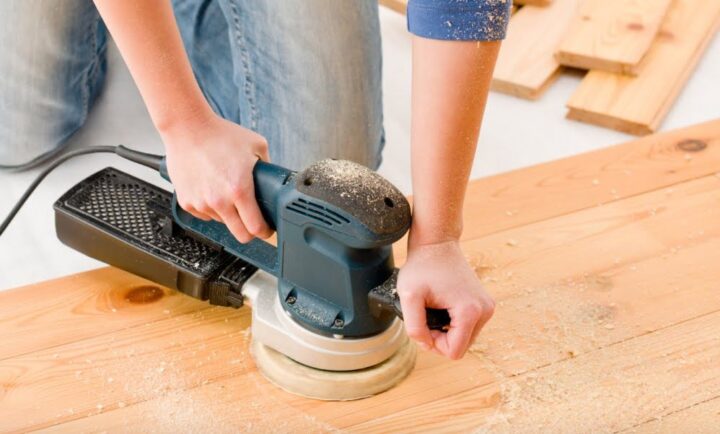
Sanding is an easy DIY task to hate: using a sanding block and sandpaper on a big job is laborious. It takes hours to complete the job, and your arms will ache for days. Fortunately, there's a power tool that can help you speed things up while reducing fatigue. So here are some good reasons to buy a good sander.
To avoid splinters
Wood is a material that needs to be handled with care, otherwise you risk getting splinters that can ruin the overall aesthetic. As well as uneven surfaces and other imperfections. Therefore, before working on it, it must be sanded, and with the right material so as not to risk making things worse.
To have a smooth surface
Sanding will make the surface of the wood smooth. This improves its appearance and will bring out the natural beauty of the wood. Especially if you want to remove milling marks (caused by a rotating blade or cutting surface). This will make the final look of your project all the more attractive later on.
To better prepare the wood for painting
A surface that is not smooth, or whose uniformity is compromised by milling marks will be difficult to paint. The roughest part will absorb more paint and be darker than the surrounding surface. As a result, there will be scratches after painting.
To round corners and edges
This will make them much more aesthetically pleasing, easier to paint and much safer: too aggressive angles on furniture such as tables or shelves can cause injuries.
The diagram below will help you to get an idea of the typical prices for each price range (entry-level, mid-range and high-end).
However, more expensive does not necessarily mean better.
We therefore advise you to always consult our ranking before deciding, rather than blindly relying on price ranges.
Remember to protect your face and ears
In addition to appropriate clothing and gloves, you should also have accessories to best protect your face and ears from dust splashes and noise pollution. So be sure to wear DIY goggles, a face mask and noise-canceling headphones or earplugs.
Carefully maintain your sander
To ensure the longevity of your sander, you should thoroughly clean it after each use. To do this, first unplug the unit. Then, remove the abrasive and dislodge the dust in all the nooks and crannies of the sander with a compressed air blower or a household vacuum cleaner brush.
Choose the right abrasive for the job
Electric sanders usually come with different types of sanding sheets. To know which one to use, refer to the type of work you will be doing. To remove an old coat of paint, for example, a 240- to 320-grit paper will do the job. On the other hand, to polish rough wood, you'll need a 16-40 grit paper.
Work in a ventilated area
To do your sanding job, choose a large, well-ventilated area, ideally your garden. If you must work indoors, however, remember to open all the windows wide. This way, you will limit your exposure to dust as much as possible.
Be sure to follow the grain direction of the wood
When sanding a wood panel, make sure you work in the direction of the grain. Also, make sure your movements are even to avoid scratching the surface. Also, consider inserting a sanding block in case the wood surface is hollow.
The following steps simply detail how to use an orbital sander:
Thematerial removal capability on a sander is determined more by the sandpaper than by the machine. Each sandpaper is designed to remove a certain amount of material, and if that amount is exceeded, the life of the paper is affected. As a general rule, you will need to use the lower grit sandpapers for heavy material removal (36-80 grit papers can remove about 1/8" to 1/32" respectively) and the medium grit papers for lighter material removal (with a grit of 100-120, the papers can remove about 1/32" to 1/64" respectively). Sanding papers with grits of 150 and above should only be used for finishing and are not considered cutting papers.
The number of heads needed depends on a variety of factors: the type of material to be sanded, the amount of stock to be removed, the finishing requirements, and the feed rate needed to meet production rates.
As a general rule, a drum is used for stock removal and a platen is used for finish sanding. However, drums are also used for finish sanding in some jobs. As a general rule, if you need to remove more than .003 to .004 inches, you should use a drum, otherwise a platen can be used. The difference between the two can also be seen upon arrival. A drum will produce a short scratch pattern, but it is deeper on a given grain. A platen will produce a longer scratch that is not as deep. You really need to determine the material removal requirements and desired finish to decide which will best suit your needs.
Every month we help more than 1 000 000 people buy better and smarter.
Copyright © 2022 - Made with ♥ by buyingbetter.co.uk
Your reviews and buying guides 0% advertising, 100% independent!